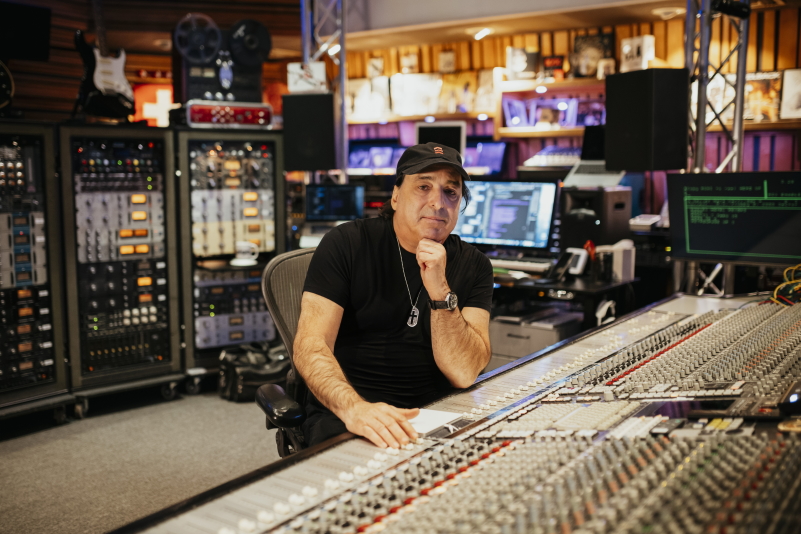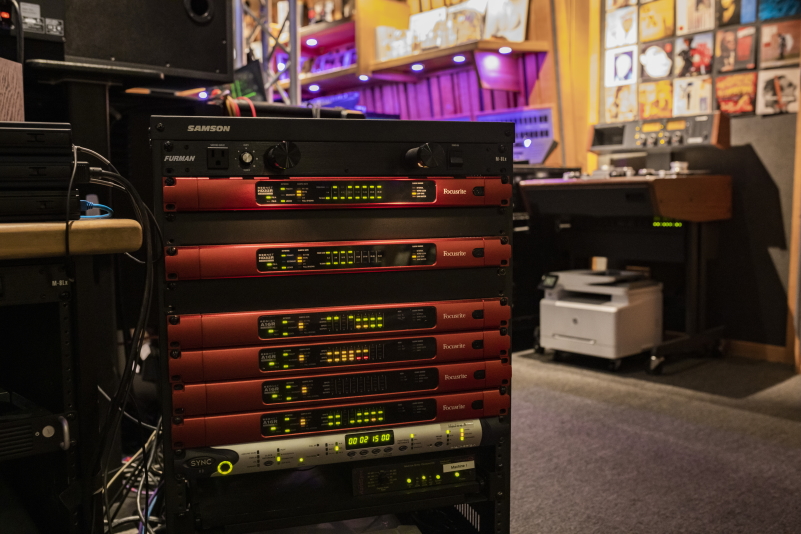Chris Lord-Alge Chooses Focusrite RedNet Interfaces

Five-time GRAMMY-winning mix engineer Chris Lord-Alge has upgraded Studio A at his MIX L.A. complex for Dolby Atmos work, facilitated by an interface and converter infrastructure based on Focusrite RedNet components. The Dante-networked RedNet setup helps interconnect two Avid Pro Tools workstations and a new 9.1.4 Ocean Way Audio speaker system with Lord-Alge’s beloved Solid State Logic SL4064E mixing console.
Lord-Alge has had to rethink his long-established workflow with the addition of the new immersive audio capabilities in Studio A, where he has mixed and remixed projects by the likes of Green Day, Keith Urban, Madonna, Rod Stewart and so many others over the years. But with encouragement from various industry colleagues, he says, “I decided to make the leap into the unknown and finally eliminate all the vintage gear that was connecting my audio to the console.”
For many years, Lord-Alge’s mixing workflow required projects to be initially transferred to a 48-track Sony DASH tape machine, which he favored for the performance of the converters and the metering (he eventually eliminated all use of tape and just used the machine’s converters). He has now replaced that machine with a Pro Tools HDX rig, operating at 96 kHz/48-bit, that feeds a pair of Focusrite RedNet HD32R 32-channel HD Dante network bridge. Using Dante Controller, Lord-Alge selects the tracks for distribution over the Dante network through four Focusrite RedNet A16R MkII 16-channel analogue interfaces and into the mixing desk. Lord-Alge’s stereo mix from the console is then routed back through one of the A16R MkII units and an HD32R HD Bridge and captured in the Pro Tools computer.
The converters in the A16R MkII units offer a noticeable improvement in performance over the DASH machine, Lord-Alge says, plus he no longer has the hassles of his former setup, where he had to synchronize the DASH machine and two Pro Tools rigs. “Once I figured out what level worked and the headroom, I found the sound of the A16R MkII was much better and clearer and more open,” he reports.
A second Pro Tools system is now dedicated solely to mixing in Dolby Atmos, which is natively 48 kHz/24-bit. “I get a great stereo mix of the record with all my colors of analog gear and an analog console and we break that out. Once I’ve done my stereo mix and I’ve created all the stems I need for Atmos, into computer number two they go. So my Atmos mixes are made from stems that are created with all the vintage outboard gear. Then computer number two with the Dolby renderer becomes my second playback system,” stated Lord-Alge.
“The second Pro Tools system doesn’t need I/O because it’s all in-the-box,” he continues. “All I need is one RedNet PCIeR Card, which gives me 128 channels over Dante at 48/24, connecting through a Mac Mini as the Dolby renderer. So Pro Tools can send 128 objects to the renderer and the monitoring. None of this would be possible without RedNet.” Monitor control of the 9.1.4 speaker rig is handled by Avid’s MTRX system.
While it does take some time to print all the stereo stems from his mix and create a session for the second Pro Tools system for mixing in Atmos, Lord-Alge says, “At this point in time, that is the way that works for me. I use the Atmos computer and the renderer for the object placement and the three-dimensionality of the mix. But for the actual nuts and bolts of creating the sonics inside the mix, I use my stereo rig.”
The MIX L.A. complex is now fully wired for Dante and RedNet, he says. “The whole room is networked with RedNet and so is my new studio next door. We can capture from there; they can capture from here. I’m able to use Dante to connect to my other studios and move forward into the future. And it works seamlessly.”
Lord-Alge, who by his own estimate has mixed more than 25,000 tracks in stereo, admits that he is a Dolby Atmos novice: “I am completely a newbie. But I’m learning about the future, about how it works and what can be done.” To that end, he says, he has received welcome support from Tom Edwards and Dave Rieley at Focusrite, Ceri Thomas at Dolby Laboratories, Allen Sides at Ocean Way Audio, and consultant and longtime friend Art Kelm, a pioneer in the technical design of Dolby Atmos rooms.

“The Focusrite support is undeniably amazing,” Lord-Alge says. “Because it’s one of those things that, once you get the puzzle pieces correct, it boots and works every time. But you have to understand how it works, and I didn’t.”
He does have some reservations about some of the Atmos music mixes that he has heard, though. “As soon as you go into Atmos with some records, everything’s exposed. Once you start to unglue it, it doesn’t have the same impact that you remember and it becomes more about, ‘Wow, I never heard that part.’ Well, maybe you weren’t supposed to hear that part. And this is the problem I have with it. I feel that a lot of records have been pulled apart and have revealed the ugly side of the song, not the good side.”
Live performances delivered in Dolby Atmos in a theater could provide the best listener experience, he believes. “I feel you should be able to go into a theater and hear these live concerts remixed in Atmos and take advantage of the three-dimensionality of it. Because when you’re in a concert, it is three-dimensional. So if you could actually do that in a theater, I think it’d be exciting.”
Lord-Alge may be a relative beginner where immersive music mixing is concerned, but he is determined to be successful at it: “I like to win. I like to have the edge. And the only way to stay ahead is to find your own path with Atmos,” he says. “I’m just letting my ears decide what works. But you know, it’s a fun ride every day, so I’m enjoying it.”
 How to resolve AdBlock issue?
How to resolve AdBlock issue?